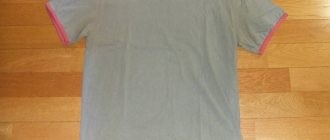Outerwear made of wool, drape and cashmere requires some care. First of all, such materials do not like large amounts of moisture and water, so it is not recommended to wash the products. It is better to clean a woolen, drape or cashmere coat only by dry cleaning. Before washing, be sure to read the label on the clothing to find out whether the material is washable and follow the recommendations.
If you washed something that cannot be washed, or washed clothes in the wrong cycle, your coat may shrink. As a result, after washing, clothes become one size or even slightly smaller. In addition, items made of wool, cashmere or drape can become deformed or shrink if stored improperly. For example, if the coat was stored for a long time in high humidity, at high temperatures or folded.
If you're caught in heavy rain, a wool, cashmere or drape coat can also become deformed, lose its appeal and shrink. However, there are several ways that will help return the coat to its previous appearance, shape and parameters. In this article we will look at how to stretch a coat at home.
How to stretch a coat
Outerwear made of wool, drape and cashmere requires some care. First of all, such materials do not like large amounts of moisture and water, so it is not recommended to wash the products. It is better to clean a woolen, drape or cashmere coat only by dry cleaning. Before washing, be sure to read the label on the clothing to find out whether the material is washable and follow the recommendations.
If you washed something that cannot be washed, or washed clothes in the wrong cycle, your coat may shrink. As a result, after washing, clothes become one size or even slightly smaller. In addition, items made of wool, cashmere or drape can become deformed or shrink if stored improperly. For example, if the coat was stored for a long time in high humidity, at high temperatures or folded.
If you're caught in heavy rain, a wool, cashmere or drape coat can also become deformed, lose its appeal and shrink. However, there are several ways that will help return the coat to its previous appearance, shape and parameters. In this article we will look at how to stretch a coat at home.
Preventing the problem
In order not to wonder in the future about how to stretch a wool item after washing, you should properly care for it, and then the problem will disappear. The rules of quality care are simple and clear:
By following these simple rules, housewives will forever forget about grueling stretching and attempts to restore the lost size of an item. If an incorrectly washed product cannot be stretched, then it will simply go into the trash bin, which is not what you want.
How to properly wash and clean a coat
To prevent a wool, drape or cashmere coat from shrinking or becoming deformed, you need to properly wash or clean the product. This material is cleaned with a soft brush. To remove strong and difficult stains, you can soak the brush in water or soap solution. For cleaning and washing, it is better to take this coat to the dry cleaner.
At home, outerwear made of wool, drape or cashmere can be washed in a delicate cycle or a special cycle for wool at a temperature not exceeding 30 degrees. Products are washed by hand at a temperature of 20-25 degrees. For washing, use special soft gels or shampoos that are suitable for this type of material.
Before washing, be sure to remove metal objects and fur elements, collar and cuffs. If possible, unfasten or open the lining and wash and dry separately. Turn the coat inside out, fasten the zippers, buttons and snaps. Place the product in a cover or laundry bag, or in a regular duvet cover or pillowcase.
Add wool conditioner when rinsing. Wash without spinning and drying in a washing machine! After water procedures, wrap your coat in a light terry towel or sheet to absorb moisture. Then lay the clothes on a horizontal surface and leave to dry in a well-ventilated area.
The coat should only be stored upright and dry in a closed closet. You can use special covers for clothes. Once every two to four weeks, take out and air the products. Regularly clean the material from dust and dirt using a special soft brush. For more information on how to properly wash, store and dry a woolen coat, read the link https://vsepodomu.ru/garderob/mozhno-li-stirat-sherstyanoe-palto/.
Source
Enlarging your jacket is easy and quick. Even a beginner can handle it
Sometimes, for a variety of reasons, we may need to enlarge clothing, such as a jacket. It would seem that the matter is complicated and you will either have to take it to a professional seamstress, or spend a long time and painstakingly making the side inserts with your own hands. However, there is an easier way to make a jacket larger, which even a fairly inexperienced person can handle.
You will need:
If your jacket does not have a belt, you can take a fabric that matches the color and texture. If it’s difficult to choose a fabric, don’t be discouraged, because in this case you can turn the place of insertion into a kind of accent. Take, for example, a contrasting color fabric or even sew some knitted pattern on top. Give free rein to your imagination.
Whatever material you choose, the algorithm for further work is the same. We take our jacket and try on the fabric and zipper on the insert. We cut off the amount we need both in length and width.
Youtube | amateur sewing
Now, in order not to rip off the zipper, we simply carefully cut it off, leaving the fabric part on the jacket.
Youtube | amateur sewing
We baste the belt or fabric and sew it on a sewing machine. We do the same with lightning. Almost done.
Youtube | amateur sewing
If there were buttons on your jacket, now we need to hide them. You shouldn’t rip off the buttons, because it won’t look very neat. We simply take the second part of our belt or fabric and hide the “stumps” of the buttons, covering them from above. We sew a strip.
Youtube | amateur sewing
This is what we had and what happened. The work took no more than 20 minutes. The insertion will only be noticeable to you, since you know about it. Others will take it as a feature of the jacket style.
Youtube | amateur sewing
You can watch a video on how to enlarge a jacket with an insert at the front at the link below.
Source
Sewing Tricks: Easy Clothes Alterations for Beginners
Three simple changes that will transform your clothes. Even beginners can master these simple techniques. Our helpful tips are creative, just check them out before discarding clothes that don't suit you.
You don't need to be an experienced seamstress to customize clothes. Here are three simple ways to change a product that any beginner can do.
We've all been in this situation: we've just found the perfect dress of our dreams for an important event, only to find that it's...
A. either not our size;
B. either simply does not suit our figure.
This problem applies not only to dresses, but to all types of clothing!
But let's face it: no two bodies are the same, and what suits one person perfectly may not fit well on another and ruin the whole look.
This is where the magic of sewing comes into play. You don't need to be a professional seamstress to make clothes fit your body.
In fact, most of these fitting skills can be adapted to different garments. And we are going to show you three basic ways:
Transformation of an old coat
Options for increasing length and width.
Welcome to the channel!
Continuing the conversation about the old coat, today I invite you to think about whether it is possible to remake your old coat at home, which has become short or small, how to save it if stains have formed that cannot be removed or there is a hole from careless use
(for example, behind a nail).
Unfortunately, as fashion designers joke: “Fashion is constantly making its last squeak, but it never dies.” It often happens that you and I buy some fashionable coat silhouette, but after a couple of seasons no one wears such coats anymore, and in order not to look funny and inappropriate, we are forced to buy a new coat again.
Rinse in peroxide
If you rinse a sweater in water with hydrogen peroxide (proportion: 2 tablespoons per 4 liters of water), leave it to “sit” in the solution for 30-40 minutes, it will certainly become a little larger. The main thing is to pull the wet sweater in different directions during the spin cycle, pulling at the sleeves and bottom. After washing, rinse and lay out to dry.
Remember to periodically tug the wool while drying to ensure results. The method is simple, but it requires some perseverance from the housewife. Don't forget that peroxide has oxidizing properties. It makes the dye appear paler, which means your sweater will look slightly faded.
Upgrade ideas
An old and unused wardrobe item does not have to be thrown away. An unnecessary product is subject to rework, and there may be several of them. By adding or changing a few elements, you can create a new stylish outfit. For example, a long style can be cut by adjusting the length. You can, on the contrary, create an elongated version. For this, lace or material of a different shade will be useful.
In order to radically change the style, you can use several options.
Note. Any dress is suitable for work, even a wedding dress. You can make a classic or evening model out of it.
How to widen or lengthen clothes. Ideas, tips and DIY master class
The situation when a beautiful and comfortable piece of clothing becomes too tight is familiar to everyone. This may be due to weight gain, pregnancy, or the wrong choice of washing or drying mode.
However, your favorite item can be remade so that it not only fits well, but also takes on a new original look.
Stylish DIY clothes
The item is wide, but the sleeves have become narrow? Use homemade shoulder straps. They can be anything: lace, embroidered or contrasting fabric.
If your favorite item has become too tight in width, use sewn-in side inserts. The material for them can be chosen in a single color or in the color of the main product.
Contrasting inserts that differ in texture and color will not only help to expand the blouse, but will also become an interesting decorative element.
This is how you can increase the size of your favorite blouse or tunic. To do this, add inserts along the back or shelf of the product.
With trousers, follow the same pattern: use side inserts along the entire length. Moreover, both from the outside and from the inside seam.
Are your previously comfortable jeans starting to put pressure on your stomach? Make inserts in the waistband area in the side or back seam.
Here's a great idea to increase the size of the dress in all respects. I already want the same for myself!
Nowadays, repairing and extending old things is not so relevant: in the era of the heyday of mass market, it is easier to buy new clothes than to remake old ones. But sometimes it’s a pity to throw away your favorite thing, you want to update or refresh it. Most often, shortening is not difficult, but lengthening beautifully is a little more difficult.
How to lengthen clothes
This is probably one of the most common methods. He looks just great! Add a strip of fabric or lace along the bottom of the product. Color and material depend on your imagination.
A very fashionable trend this season is an insert made of transparent fabric. Place it on the hem of a skirt or light summer dress.
And this is an even more radical transformation of trousers. Openwork inserts are placed not at the bottom, but in the middle of the product. To enhance the effect, you can decorate your pockets and belt with lace. Personally, I really like this option.
For girls who love a sporty style of clothing, knitted cuffs will be an excellent option for changing the shape of trousers.
If we talk about blouses and jumpers, there are a huge number of options. The most popular of them are lace inserts at the bottom of the product.
Looking at this photo, I immediately wanted to have the same summer T-shirt. To remake it, you need to make a contrasting fabric insert in the middle of the product.
As you can see, you don’t always need to throw away a tight blouse or a too short skirt, especially if it concerns your favorite clothes. Use these simple but resourceful tricks and stay on trend!
So, I have a shirt, good and expensive, but I’m terribly bored with it. Having scoured the Internet, I came across one wonderful master class that solved the problem of two things at once - a shirt and a guipure top, which my sister-in-law gave me and which I really dislike.
How to widen or lengthen clothes. Ideas, tips and DIY master class
- Let's start by cutting off the sleeves and shoulders of our old shirt. By the way, here is a variant of the black and white style, but if you add a little imagination, you can achieve the coolest results of the alteration.
— Using the cut off shoulders as a base, we cut out exactly the same ones from guipure or lace. The most interesting thing is transforming old clothes into stylish ones with your own hands, when you realize that the result will exceed all expectations.
— Carefully trim our guipure patch and distribute it over the surface of the table to slightly overcast the edges, if necessary.
— We begin to sew the guipure patch to the shoulders of the shirt; you can either use a machine or sew it by hand.
— We sew very carefully from the side of the collar so that no seams stick out, because they will rub your shoulders.
- Well, that's all, with just a little effort you can have a gorgeous new shirt to brighten up your wardrobe, and you haven't spent any of your budget on it.
But we don’t say goodbye to you here, come back again!
Remaking things is my favorite pastime!
Things fall out of use for various reasons: they don’t fit, they’re out of fashion, there’s a stain or a hole in a visible place. But the fabric is still quite usable, why not remake it and continue to wear it?
Beautiful, original, budget-friendly!
I bring to your attention the idea of using leftovers and scraps of knitwear, as well as reworking existing items, for example, in this way you can quite simply lengthen the sleeves on children's clothing, just cut them and crochet the pieces. Fresh and cool ideas!
However, I really liked the dresses too.
Remodeling idea
Who's talking about what, and I'm talking about alterations. Not because I love the process, but because I love ideas. They often help turn standard clothing into something original, and therefore wearable with pleasure.
Remodeling idea
The other day I came across some very interesting solutions. Each of which can be interpreted in your own way and tied to your wardrobe. You can make something original out of what you have in your wardrobe. If not for yourself (at home/dacha), then for your children and grandchildren.
For example, a jumper is a knitted product without a collar or fastener. You can diversify it by wearing a) with a skirt/trousers; b) a blouse-shirt underneath. The options are quickly running out, as is the time of year and the desire to wear it. Here's an idea that will help the jumper stay in your wardrobe for some time.
Making home (and why only home?) trousers narrow, that is, practical, would also not be bad.
This, of course, is one of the fashionable clothes on sale, but... very inspiring.
Note: this photo-memo is on my desktop as a reminder of ruined blouses-shirts with low armholes.
As a bit of a sewer, I start the alteration by ripping out the sleeves, and that’s where I finish - because the low armhole is already difficult to use afterwards, there are a lot of problems. There is no need to steam the sleeves.
A nice result in my opinion. Children will especially like it.
You can cut T-shirts not only in straight lines. Creative idea for a T-shirt. Let it be for her home and country purposes.
Boho style: a lot of everything. Your version may be much more modest.
Men's shirts are in business! For example, in a dress for a girl.
“You always need an apron,” a friend told me, asking me to find a simple pattern. I don't have aprons at all. And it never was. But on my silk blouses (you won’t change your clothes before toasting a couple of toasts for a guest) greasy spots often appear, which, alas, fade into spots during communication.
Source
Making a new dress
Having ready-made samples greatly simplifies the work process. First of all, you need to decide what exactly needs to be changed . This determines which seams will need to be ripped out during the process.
Advice. If only the length and style of the sleeve changes, the side seams and hem line can be left unchanged.
An important step is the preparation of the product itself. The material must be clean and well ironed .
Tools for work
To make a new dress based on an existing one, you will need the following.
Completing of the work
After preparation, we begin the technological process. The necessary seams must be opened and the remaining threads carefully removed. The pattern is transferred to the fabric . A small piece of chalk is suitable for marking the outline. When working, it is important to leave seam allowances of about a centimeter. After preparation, each element is carefully cut out.
Advice. When working on a sewing machine, it is first recommended to process the shoulder seams and sleeves.
Many craftswomen treat the neck area with bright trim. Afterwards you can start working on the side seams and finishing the bottom.
Advice . Before you start sewing on a machine, you can overcast the parts and try on the product. This will help to correct any errors in a timely manner.
Sewing the jacket to size yourself
Now let's look at how you can sew a jacket yourself, depending on where it is too big.
How to sew a jacket at the waist
One of the easiest ways to reduce your clothing size.
Typically its value ranges from 3.5 mm to 4.5 mm.
At the end of the work, you should try on the updated jacket.
How to sew a jacket on the back
For this option, you also need to decide on the scale and at what seams you will sew the item.
Now all that remains is to turn the clothes inside out so that they are right side out.
How to hem jacket sleeves
First you need to rip the fabric, namely its seam, on the sleeve (this seam should connect to the cuff). You should first measure the length you want to bend with a ruler. Most often this happens from about one and a half to three centimeters. Next, measure the distance from the edge to the straight line, which, therefore, will be the line of the new sleeve (take into account seam allowances). We shorten the lining to the same place. After this, compare the fabric and lining, they should be exactly aligned.
Source










